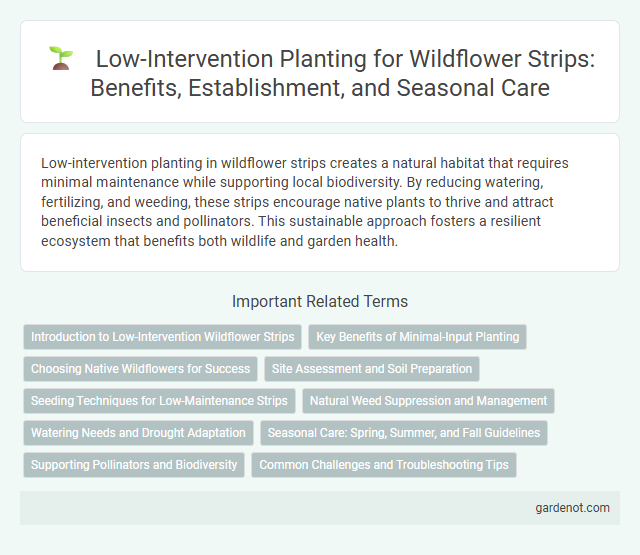Low-intervention planting in wildflower strips creates a natural habitat that requires minimal maintenance while supporting local biodiversity. By reducing watering, fertilizing, and weeding, these strips encourage native plants to thrive and attract beneficial insects and pollinators. This sustainable approach fosters a resilient ecosystem that benefits both wildlife and garden health.
Introduction to Low-Intervention Wildflower Strips
Low-intervention wildflower strips require minimal maintenance, allowing native plants to establish and thrive naturally, which enhances biodiversity and supports local pollinators. These strips reduce the need for frequent mowing, watering, or fertilizing, promoting sustainable habitat creation with lower resource input. Incorporating native wildflowers resilient to local conditions ensures ecological balance and long-term sustainability in low-intervention planting schemes.
Key Benefits of Minimal-Input Planting
Low-intervention planting in wildflower strips promotes biodiversity by allowing native species to establish naturally, reducing the need for herbicides and fertilizers. This minimal-input approach conserves soil health and water resources while supporting pollinators like bees and butterflies. Enhanced ecosystem resilience and lower maintenance costs are key benefits driving sustainable landscaping practices.
Choosing Native Wildflowers for Success
Selecting native wildflowers tailored to your specific region ensures optimal growth and supports local biodiversity in low-intervention wildflower strips. Native species require minimal watering, fertilization, or pest control, making them ideal for sustainable, low-maintenance planting. Prioritizing drought-tolerant and pollinator-friendly varieties enhances ecological benefits and long-term garden success.
Site Assessment and Soil Preparation
Effective wildflower strip establishment begins with comprehensive site assessment, including soil texture, pH, and nutrient levels to select compatible native species. Low-intervention planting emphasizes minimal soil disturbance, achieved by light tilling or direct seeding on prepared seedbeds to maintain soil structure and microbial health. Ensuring proper soil preparation through removing debris and addressing compaction enhances seed-to-soil contact and promotes successful germination and plant establishment.
Seeding Techniques for Low-Maintenance Strips
Seeding techniques for low-maintenance wildflower strips emphasize minimal soil disturbance and the use of native seed mixes adapted to local climates and soil conditions. Broadcasting seeds during early spring or late fall optimizes germination rates while reducing weed competition, promoting natural establishment without intensive care. Selecting a diverse blend of perennial wildflowers ensures resilience, supports pollinators, and maintains ecological balance with limited ongoing intervention.
Natural Weed Suppression and Management
Low-intervention planting in wildflower strips promotes natural weed suppression by encouraging diverse native species that outcompete invasive plants. This method reduces reliance on herbicides and mechanical weeding, enhancing soil health and biodiversity. Maintaining a balanced ecosystem through selective seeding and minimal disturbance supports long-term, sustainable weed management.
Watering Needs and Drought Adaptation
Low-intervention wildflower strips prioritize native species with deep root systems that enhance drought adaptation by efficiently accessing soil moisture. These plants typically require minimal watering once established, relying on natural rainfall and conserving water through xerophytic traits. Selecting drought-tolerant varieties reduces irrigation demands while supporting biodiversity and soil health in arid or semi-arid environments.
Seasonal Care: Spring, Summer, and Fall Guidelines
Low-intervention planting in wildflower strips supports biodiversity with minimal disturbance, emphasizing natural growth cycles. In spring, focus on light mowing to prevent woody species encroachment while promoting early bloomers; summer requires selective weeding to reduce aggressive grasses and maintain floral diversity. Fall guidelines include cutting back dead growth and avoiding heavy soil disturbance to preserve seed banks for natural regeneration.
Supporting Pollinators and Biodiversity
Low-intervention planting in wildflower strips enhances pollinator habitats by minimizing soil disturbance and chemical inputs, fostering a diverse array of native plant species that provide essential nectar and pollen sources. This approach supports biodiversity by creating stable ecosystems where beneficial insects, birds, and soil organisms thrive, contributing to natural pest control and improved soil health. Wildflower strips established with minimal intervention promote resilience against environmental stressors and encourage the proliferation of key pollinator populations such as bees, butterflies, and hoverflies.
Common Challenges and Troubleshooting Tips
Low-intervention wildflower strips often face challenges such as weed invasion, soil compaction, and inconsistent flowering due to minimal maintenance. Managing these issues involves selective manual weeding, periodic soil aeration, and monitoring plant diversity to ensure native species dominance. Regular observation helps identify pest outbreaks early, allowing targeted interventions that preserve the ecological balance and promote thriving wildflower habitats.
Low-intervention planting Infographic

 gardenot.com
gardenot.com